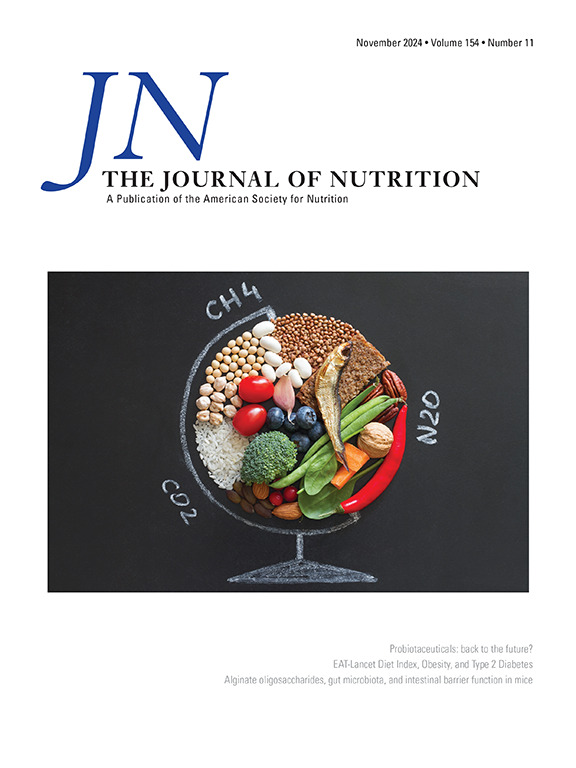加拿大居民的维生素D摄入量:使用2015年加拿大社区健康调查-营养分类人口数据的评估
IF 3.7
3区 医学
Q2 NUTRITION & DIETETICS
引用次数: 0
摘要
背景:维生素D的膳食参考摄入量是为了支持足够的维生素D状态而设定的。在加拿大,根据生物标志物数据,维生素D不足的患病率为19%。目的:本研究的目的是评估居住在加拿大的人的维生素D的总通常摄入量(UI)的充分性;并探索社会人口统计学的相关性。方法:使用2015年加拿大社区健康调查-营养(n=19,567,≥1年)的维生素D摄入数据。UI不足的发生率定义为低于估计平均需求(%UL)的百分比。结论:在加拿大,维生素D摄入不足的人群患病率很高,但在补充剂使用者中患病率较低。自本次调查以来,膳食指南建议年龄≥2岁且每日不摄入维生素D食物来源的人补充维生素D。随后,牛奶、人造黄油和FPBB中的维生素D含量增加,并允许在酸奶和酸奶中添加维生素D。这些策略可以帮助居住在加拿大的人们获得足够的维生素D摄入量。本文章由计算机程序翻译,如有差异,请以英文原文为准。
Vitamin D Intakes of People Living in Canada: An Assessment Using Disaggregated Population Data from the 2015 Canadian Community Health Survey – Nutrition
Background
The dietary reference intakes for vitamin D were set in support of adequate vitamin D status. In Canada, the prevalence of inadequate vitamin D status is 19% based on biomarker data.
Objectives
The objectives of this study are to assess the adequacy of total usual intakes (UIs) of vitamin D of people living in Canada and explore sociodemographic correlates.
Methods
Vitamin D intake data from the 2015 Canadian Community Health Survey – Nutrition (n = 19,567, ≥1 y) were used. The prevalence of inadequate UI was defined as the percent below the estimated average requirement (%<EAR, 10 μg/d); risk of excess intakes was defined as the percent above the tolerable upper intake level (%>UL). Intakes (%<EAR and μg/d) of supplement users and nonusers were summarized by age–sex groups and sociodemographic factors. The top natural and fortified [mandated: cow’s milk and margarine; voluntary: plant-based beverages (PBBs)] food sources of vitamin D were explored.
Results
In supplement nonusers, %<EAR was ≥85.2% across age–sex groups. In supplement users (33.5%, 95% confidence interval: 32.1%, 34.8%), %<EAR ranged from 7.9% to 54.2% among age–sex groups. Overall, the %>UL was <3%. Total UI of vitamin D in supplement nonusers and users did not vary widely according to sociodemographic factors. Overall, the top 4 food sources of vitamin D were cow’s milk and fortified plant-based beverages (FPBBs) combined, margarine, fish, and eggs.
Conclusions
In Canada, the population prevalence of inadequate vitamin D intake is high, although lower among supplement users. Since the time of this survey, dietary guidance advises vitamin D supplementation for people ≥2 y who do not consume a daily food source of vitamin D. Subsequently, the amount of vitamin D in milks, margarines, and FPBB was increased and its addition to yogurts and kefirs was permitted. These strategies may help people living in Canada to achieve adequate intakes of vitamin D.
求助全文
通过发布文献求助,成功后即可免费获取论文全文。
去求助
来源期刊

Journal of Nutrition
医学-营养学
CiteScore
7.60
自引率
4.80%
发文量
260
审稿时长
39 days
期刊介绍:
The Journal of Nutrition (JN/J Nutr) publishes peer-reviewed original research papers covering all aspects of experimental nutrition in humans and other animal species; special articles such as reviews and biographies of prominent nutrition scientists; and issues, opinions, and commentaries on controversial issues in nutrition. Supplements are frequently published to provide extended discussion of topics of special interest.
 求助内容:
求助内容: 应助结果提醒方式:
应助结果提醒方式:


